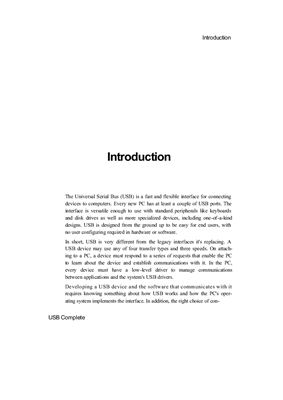Axelson J. USB Complete. Second Edition (2001)
Introduction
The Universal Serial Bus (USB) is a fast and flexible interface for connecting devices to computers. Every new PC has at least a couple of USB ports. The interface is versatile enough to use with standard peripherals like keyboards and disk drives as well as more specialized devices, including one-of-a-kind designs. USB is designed from the ground up to be easy for end users, with no user configuring required in hardware or software.
In short, USB is very different from the legacy interfaces it's replacing. A USB device may use any of four transfer types and three speeds. On attaching to a PC, a device must respond to a series of requests that enable the PC to lea about the device and establish communications with it. In the PC, every device must have a low-level driver to manage communications
between applications and the system's USB drivers.
Developing a USB device and the software that communicates with it requires knowing something about how USB works and how the PC's operating system implements the interface. In addition, the right choice of contrailer chip, device class, and tools and techniques can go a long way in
avoiding snags and simplifying what needs to be done. This book is a guide for developers of USB devices. Its purpose is to introduce you to USB and to help get your project up and running and troublefree as quickly and easily as possible.
Introduction
The Universal Serial Bus (USB) is a fast and flexible interface for connecting devices to computers. Every new PC has at least a couple of USB ports. The interface is versatile enough to use with standard peripherals like keyboards and disk drives as well as more specialized devices, including one-of-a-kind designs. USB is designed from the ground up to be easy for end users, with no user configuring required in hardware or software.
In short, USB is very different from the legacy interfaces it's replacing. A USB device may use any of four transfer types and three speeds. On attaching to a PC, a device must respond to a series of requests that enable the PC to lea about the device and establish communications with it. In the PC, every device must have a low-level driver to manage communications
between applications and the system's USB drivers.
Developing a USB device and the software that communicates with it requires knowing something about how USB works and how the PC's operating system implements the interface. In addition, the right choice of contrailer chip, device class, and tools and techniques can go a long way in
avoiding snags and simplifying what needs to be done. This book is a guide for developers of USB devices. Its purpose is to introduce you to USB and to help get your project up and running and troublefree as quickly and easily as possible.

